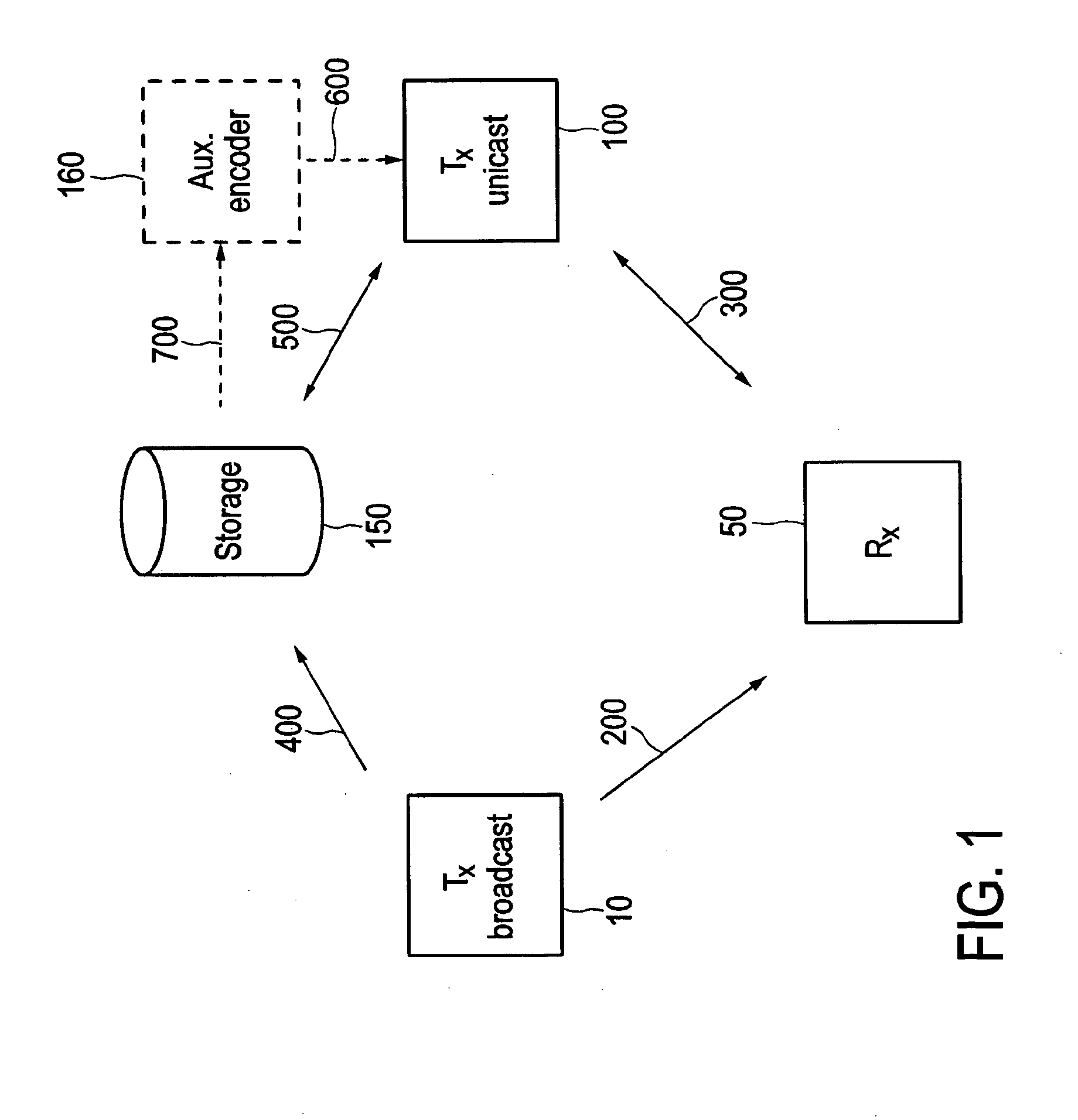Receiver and receiving method for receiving data in a broadcast system using incremental redundancy received through a unicast system
a technology of receiving method and receiving method, which is applied in the direction of coding, code conversion, fault response, etc., to achieve the effect of increasing the probability of error-free reception/reconstruction of data by a mobile receiver
- Summary
- Abstract
- Description
- Claims
- Application Information
AI Technical Summary
Benefits of technology
Problems solved by technology
Method used
Image
Examples
embodiment 142
[0105]In an alternative embodiment 142 as depicted in FIG. 11 the encoding unit 30a only comprises the FEC encoder 31 for generation of the codeword Z2 (or only of the auxiliary codeword portion A or of the auxiliary parity portion Pa, respectively). In this case the output data of the encoding unit 30a is not transferred to the data storage 150 by a broadcast, but is transferred via a different channel, e.g. through a wired line connecting the broadcast transmitter 10 and the data storage(s) 150. Also in this case the data received by the data storage(s) 150 can be considered to be highly reliable.
embodiment 143
[0106]In a further embodiment 143 of the encoder 14 as depicted in FIG. 12 only a single encoding unit 20 is provided for generation of the basic codeword portion B only, i.e. comprising only a data portion D and a basic parity portion Pb. In this case, the auxiliary codeword portion A is not generated by the broadcast transmitter 10, in particular its encoder 14, but generally the data portion D and / or the basic codeword portion B is stored in the data storage 150. Hence, if an auxiliary codeword portion A is later requested by the receiver 50, this auxiliary codeword portion A must be generated on the fly from the stored data portion D or the stored basic codeword portion B as will be explained below. Here, using stored basic codeword portions B is preferred for this generation of auxiliary codeword portions on the fly, since often this requires less time if these portions are accumulated to obtain a “total” codeword, as is often the case (see §6.1.2.1 of the DVB-T2 standard).
[010...
embodiment 144
[0113]A still further embodiment 144 of an encoder 14 is illustrated in FIG. 13. Said encoder 144 is adapted such that it generates two or more auxiliary parity subportions Pa1, Pa2, Pa3 in addition to the data portion D and the basic parity portion Pb thus forming a codeword Z3. Hence, comparing the codewords Z2 and Z3, the auxiliary parity sub-portions Pa1, Pa2, Pa3 of the codeword Z3 can be seen as segments of the auxiliary parity portion Pa of the codeword Z2, having in total the identical content, although generally the auxiliary parity sub-portions Pa2 and Pa3 can also be additional auxiliary parity portions in addition to the auxiliary parity portion Pa1 that (alone) corresponds to the auxiliary parity portion Pa. It shall, however, be noted that the other embodiments 141, 142, 143 of the encoder 14 shown in FIGS. 3, 11, 12 are generally also able to generate two or more auxiliary parity sub-portions Pa1, Pa2, Pa3 (rather than a single auxiliary parity portion Pa) in addition...
PUM
 Login to View More
Login to View More Abstract
Description
Claims
Application Information
 Login to View More
Login to View More - R&D
- Intellectual Property
- Life Sciences
- Materials
- Tech Scout
- Unparalleled Data Quality
- Higher Quality Content
- 60% Fewer Hallucinations
Browse by: Latest US Patents, China's latest patents, Technical Efficacy Thesaurus, Application Domain, Technology Topic, Popular Technical Reports.
© 2025 PatSnap. All rights reserved.Legal|Privacy policy|Modern Slavery Act Transparency Statement|Sitemap|About US| Contact US: help@patsnap.com



